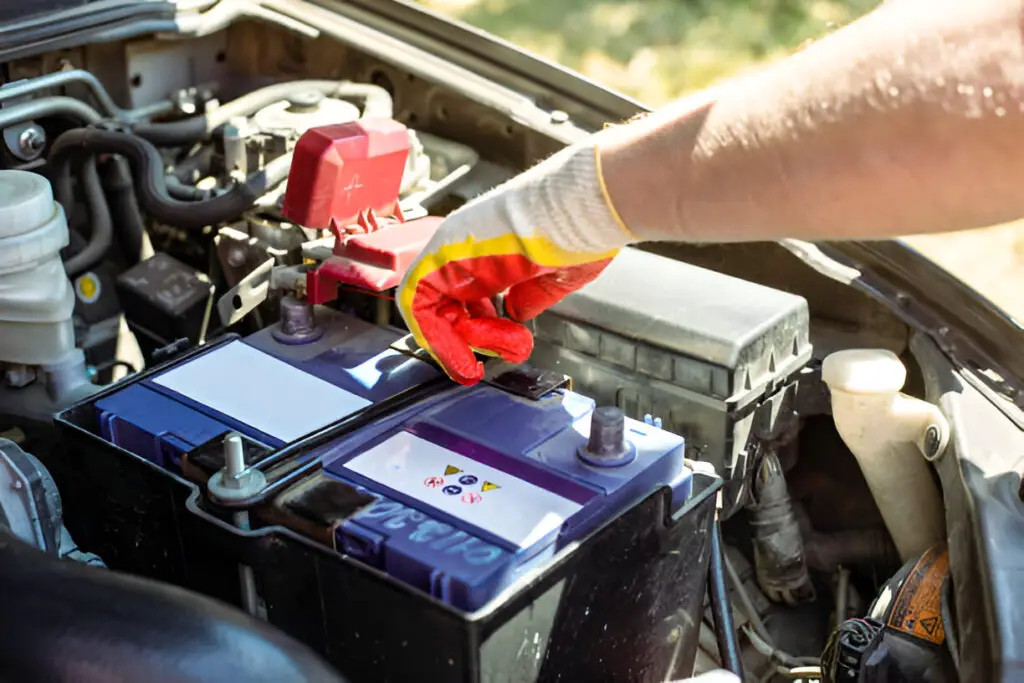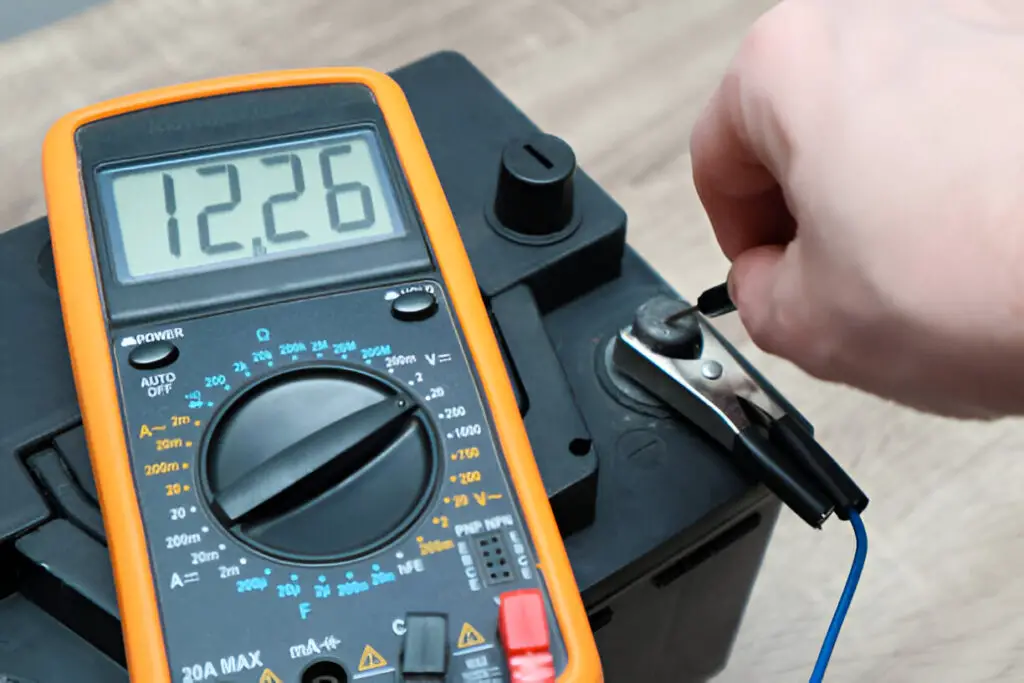f your car battery isn’t charging while driving, the issue is likely related to a faulty alternator, a worn serpentine belt, or corroded battery connections. The alternator may not be generating enough power to charge the battery, or loose connections could be interrupting the charge.
Car battery plays a critical role in ensuring that your vehicle runs smoothly. It provides the electrical power necessary for starting the car, running the lights, and operating other electronic components. Normally, once the car is running, the alternator takes over to keep the battery charged. But what happens if your car battery isn’t charging while you’re driving?
This can be a serious issue, leaving you stranded with a dead battery. In this blog, we will explore the possible reasons why your car battery may not be charging while driving, how to diagnose the problem, and ways to fix and prevent this issue.

Contents
How the Car Charging System Works
To understand why your car battery might not be charging while driving, it helps to have a basic understanding of how the charging system works. There are three key components involved in keeping your battery charged:
- Battery: The battery stores electrical energy that is used to start the engine and power electrical components when the car is off.
- Alternator: Once the car is running, the alternator takes over and generates electricity to recharge the battery and run the car’s electrical systems. The alternator converts mechanical energy from the engine into electrical energy.
- Voltage Regulator: The voltage regulator ensures that the alternator sends the correct amount of voltage to the battery. It protects the battery from being overcharged or undercharged.
When the charging system is functioning properly, the alternator continuously recharges the battery as you drive. However, if something goes wrong, the battery may begin to drain without recharging, leaving you with a dead battery.
Reasons Why the Car Battery Is Not Charging While Driving
If the car battery is not charging while driving, there are several common reasons that could be causing the issue. These problems generally relate to the charging system, which consists of the battery, alternator, voltage regulator, and associated wiring. Below are some of the most common reasons why a car battery may not charge while driving:
1. Faulty Alternator
The most common cause of a battery not charging while driving is a malfunctioning alternator. If the alternator is damaged or worn out, it won’t be able to generate enough electricity to keep the battery charged. Symptoms of a bad alternator may include dimming headlights, dashboard warning lights, or a whining noise under the hood.
Signs of a faulty alternator:
- Battery warning light on the dashboard
- Dimming headlights or electrical accessories
- Strange noises (whining or grinding) from the alternator
- Difficulty starting the car
Solution: If you suspect that the alternator is at fault, it will need to be tested alternator and potentially replaced. An automotive technician can measure the output voltage of the alternator to determine if it’s producing the correct amount of electricity. If not, replacing the alternator is the only solution.
2. Bad Battery
Even though the alternator is the primary culprit in many cases, a weak or defective battery can also cause charging issues. If the battery is old or damaged, it may not be able to hold a charge, regardless of the alternator’s performance.
Signs of a bad battery:
- Car won’t start, or takes longer to start (clicking sound)
- Corrosion on battery terminals
- Swollen battery case
- Battery won’t hold a charge after jump-starting
Solution: A battery that won’t hold a charge even after being recharged is likely past its useful life. If the battery is more than 3-5 years old, it may be time for a replacement.
3. Worn or Loose Serpentine Belt
The alternator is driven by a serpentine belt connected to the engine. If this belt is worn, frayed, or loose, it may slip and prevent the alternator from properly charging the battery. In some cases, the belt may break entirely, stopping the alternator from working altogether.
Signs of a worn or loose serpentine belt:
- Squealing noise when starting the engine or while driving
- Visible wear, cracks, or fraying on the belt
- Power steering and air conditioning failure (because these systems also rely on the serpentine belt)
Solution: If the serpentine belt is loose or damaged, it should be tightened or replaced. This is a relatively inexpensive fix but crucial for proper vehicle operation.
4. Blown Fuses or Fusible Links
Most modern vehicles use fuses or fusible links to protect the electrical components from damage due to electrical surges or faults. A blown fuse in the charging system can interrupt the circuit between the alternator and battery, causing the battery not to charge.
Signs of a blown fuse or fusible link:
- Electrical components fail to operate (lights, radio, etc.)
- Battery not charging, even with a new alternator
- No signs of life in the charging system
Solution: Check the car’s fuse box for any blown fuses and replace them as necessary. If fusible links are blown, they will need to be replaced by a professional mechanic.
5. Corroded or Loose Battery Connections
Sometimes the problem is not with the alternator or the battery but rather the connections between them. Corroded or loose battery terminals can prevent the alternator from properly recharging the battery, leading to charging problems.
Signs of corroded or loose connections:
- Visible white, blue, or green corrosion on the battery terminals
- Loose battery cables
- Flickering lights or intermittent electrical problems
Solution: Clean the battery terminals and tighten the connections. Battery terminal cleaner is widely available and can be used to remove corrosion. Ensure all cables are securely attached to prevent further issues.
6. Faulty Voltage Regulator
The voltage regulator ensures the alternator sends the right amount of voltage to the battery. If it malfunctions, the alternator might not send enough power to recharge the battery or could send too much, causing overcharging.
Signs of a faulty voltage regulator:
- Battery warning light on the dashboard
- Overheating battery
- Electrical components malfunctioning (lights flickering, etc.)
Solution: Replacing a faulty voltage regulator may require professional assistance, as it is often integrated with the alternator. If the voltage regulator is part of the alternator assembly, the entire alternator may need to be replaced.

How to Diagnose Car Battery isn’t Charging While Driving Issue
To figure out why your car battery isn’t charging while driving, follow these diagnostic steps:
- Check the Battery: Start by testing the battery with a voltmeter. With the engine off, a fully charged battery should measure around 12.6 volts. When the engine is running, it should read between 13.7 and 14.7 volts. If the voltage is lower, there’s a charging issue.
- Inspect the Alternator: Listen for any unusual sounds from the alternator, such as grinding or whining. You can also have the alternator tested at most auto parts stores or with a professional mechanic.
- Examine the Serpentine Belt: Look for any signs of wear, cracks, or looseness in the serpentine belt. If it appears worn or damaged, it should be replaced.
- Check for Blown Fuses: Locate the vehicle’s fuse box and check the fuses related to the charging system. If any are blown, replace them.
- Inspect Battery Terminals: Look for any corrosion or looseness at the battery terminals. Clean off any corrosion and tighten the terminals if necessary.
Prevention Tips for Battery Charging Problems
To prevent battery charging problems while driving, it’s essential to maintain your car’s charging system regularly and address issues early. Here are some key prevention tips to keep your battery and charging system in optimal condition:
- Regular Maintenance: Ensure your alternator, battery, and voltage regulator are inspected during regular vehicle maintenance. Most mechanics will check these components during routine tune-ups.
- Replace the Serpentine Belt: Don’t wait until the belt is severely worn. Replace it according to your vehicle manufacturer’s recommendations, usually every 60,000 to 100,000 miles.
- Clean Battery Terminals: Check the battery terminals for corrosion regularly and clean them as needed to maintain a good connection.
- Pay Attention to Warning Lights: Don’t ignore the battery warning light on your dashboard. If it comes on while driving, have the charging system inspected immediately.
Frequently Asked Questions
Here are some FAQs about battery charging problem –
1. Why is my battery light on while I’m driving?
The battery light typically comes on if your battery isn’t charging correctly. This could indicate a problem with the alternator, voltage regulator, serpentine belt, or battery connections.
2. Can I drive my car if the battery isn’t charging?
While you may be able to drive a short distance, you’ll eventually lose power as the battery drains. It’s best to stop and address the issue as soon as possible to avoid being stranded.
3. How long can I drive with a faulty alternator?
If the alternator fails, your car will run on the battery’s reserve power. Depending on the battery’s charge and your usage of electrical components, this could last anywhere from 30 minutes to a couple of hours.
4. How do I know if the problem is with the battery or the alternator?
Test the battery with a voltmeter. If it’s under 12.6 volts with the engine off or below 13.7 volts with the engine running, the alternator may be the issue. If the battery struggles to hold a charge even after being jump-started, it may need replacing.
5. What should I do if the battery won’t charge after replacing the alternator?
If the battery still won’t charge after replacing the alternator, check the voltage regulator, fuses, serpentine belt, and battery connections. It’s also possible the battery itself is bad and needs replacing.
Conclusion
A car battery that won’t charge while driving can be caused by several factors, ranging from a faulty alternator to simple issues like corroded battery connections. By understanding the symptoms and knowing how to diagnose the issue, you can take the appropriate steps to fix the problem and prevent further issues down the road. Always pay attention to warning signs and perform regular maintenance to keep your vehicle’s charging system in good working order.